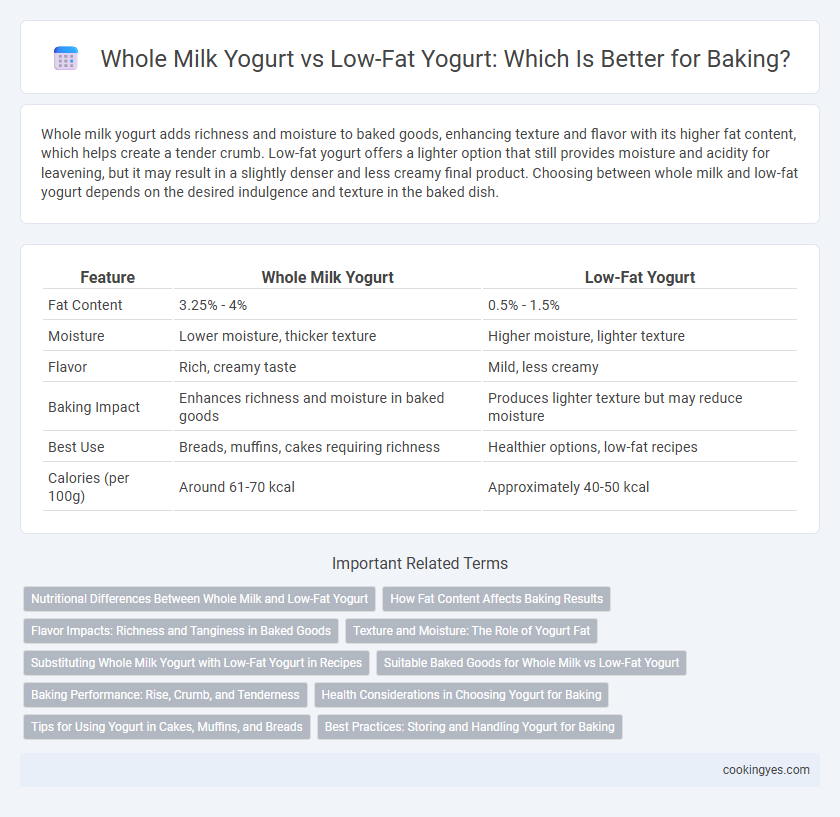Whole milk yogurt adds richness and moisture to baked goods, enhancing texture and flavor with its higher fat content, which helps create a tender crumb. Low-fat yogurt offers a lighter option that still provides moisture and acidity for leavening, but it may result in a slightly denser and less creamy final product. Choosing between whole milk and low-fat yogurt depends on the desired indulgence and texture in the baked dish.
Table of Comparison
| Feature | Whole Milk Yogurt | Low-Fat Yogurt |
|---|---|---|
| Fat Content | 3.25% - 4% | 0.5% - 1.5% |
| Moisture | Lower moisture, thicker texture | Higher moisture, lighter texture |
| Flavor | Rich, creamy taste | Mild, less creamy |
| Baking Impact | Enhances richness and moisture in baked goods | Produces lighter texture but may reduce moisture |
| Best Use | Breads, muffins, cakes requiring richness | Healthier options, low-fat recipes |
| Calories (per 100g) | Around 61-70 kcal | Approximately 40-50 kcal |
Nutritional Differences Between Whole Milk and Low-Fat Yogurt
Whole milk yogurt contains higher fat content, typically around 3.5% to 4%, providing richer flavor and creamier texture ideal for baking recipes that benefit from moisture and tenderness. Low-fat yogurt generally has 0.5% to 2% fat, offering fewer calories and less saturated fat, which can result in a lighter, less rich baked product. The protein content remains relatively similar in both, but the fat differences significantly influence the nutritional profile and baking outcomes.
How Fat Content Affects Baking Results
Whole milk yogurt enhances baking by adding richer moisture and tenderness due to its higher fat content, resulting in softer and more flavorful baked goods. Low-fat yogurt produces a denser texture with less moisture, which can lead to drier, firmer outcomes. The fat in whole milk yogurt also aids in browning and improves crumb structure, making it preferable for recipes where richness and texture are essential.
Flavor Impacts: Richness and Tanginess in Baked Goods
Whole milk yogurt enhances baked goods with a creamy richness and deeper tanginess that intensifies flavor complexity, making it ideal for recipes where moisture and texture are key. Low-fat yogurt delivers a milder tang with less creaminess, which can result in lighter, less dense baked items but may sacrifice some flavor depth. Choosing between the two depends on desired outcome: whole milk yogurt contributes a fuller body and richer taste, while low-fat yogurt provides subtle tang without overwhelming other ingredients.
Texture and Moisture: The Role of Yogurt Fat
Whole milk yogurt enhances baking texture by providing richer moisture and a creamier crumb due to its higher fat content, which helps retain softness in cakes and muffins. Low-fat yogurt results in drier, denser textures since it lacks sufficient fat to contribute to tender, moist baked goods. Fat in whole milk yogurt also aids in emulsifying ingredients, leading to more consistent batter and improved moisture retention during baking.
Substituting Whole Milk Yogurt with Low-Fat Yogurt in Recipes
Substituting whole milk yogurt with low-fat yogurt in baking affects texture and moisture due to the lower fat content, which can result in slightly less rich and dense baked goods. Low-fat yogurt contains less fat and more water, potentially causing batter to be thinner and baked items to be less tender or moist. To compensate, adjustments such as adding a small amount of extra fat like butter or oil may be necessary for optimal texture and flavor in recipes.
Suitable Baked Goods for Whole Milk vs Low-Fat Yogurt
Whole milk yogurt's rich fat content enhances moisture and tenderness in baked goods like muffins, cakes, and breads, resulting in a denser, creamier texture. Low-fat yogurt works well in recipes where a lighter crumb is desired, such as pancakes, quick breads, and healthier fruit-based desserts, providing moisture without added heaviness. Choosing between whole milk and low-fat yogurt depends on the desired texture, richness, and nutritional profile of the final baked product.
Baking Performance: Rise, Crumb, and Tenderness
Whole milk yogurt enhances baking performance by contributing to a tender crumb and richer rise due to its higher fat content, which helps retain moisture and improve texture. Low-fat yogurt results in a lighter rise with a slightly denser crumb and less tenderness, as reduced fat impacts moisture retention and gluten development. Choosing whole milk yogurt in recipes optimizes softness and overall mouthfeel in baked goods.
Health Considerations in Choosing Yogurt for Baking
Whole milk yogurt contains higher fat content, which contributes to richer texture and moisture in baked goods, while low-fat yogurt offers fewer calories and less saturated fat, making it a healthier option for those monitoring fat intake. The probiotics in both varieties support digestive health, but the reduced fat in low-fat yogurt can make recipes slightly less tender without altering flavor significantly. Choosing the right yogurt depends on balancing health goals with desired baking outcomes, as fat content influences both nutrition and texture in baked products.
Tips for Using Yogurt in Cakes, Muffins, and Breads
Whole milk yogurt adds rich moisture and tender crumb to cakes, muffins, and breads, enhancing flavor while maintaining a soft texture. Low-fat yogurt provides a lighter option with less fat content but can yield denser baked goods, so consider adjusting liquid ingredients for balance. For best results, substitute yogurt for buttermilk or sour cream using equal amounts, and avoid overmixing batter to retain airiness.
Best Practices: Storing and Handling Yogurt for Baking
Whole milk yogurt offers richer texture and moisture retention in baked goods, but requires careful storage at or below 40degF to prevent spoilage. Low-fat yogurt has a thinner consistency, making it ideal for lighter recipes, yet it should be handled gently to avoid curdling during mixing and stored in airtight containers to maintain freshness. For optimal baking results, always use yogurt within its expiration date and bring it to room temperature before incorporation to ensure even blending and texture consistency.
Whole milk yogurt vs low-fat yogurt for baking Infographic

 cookingyes.com
cookingyes.com